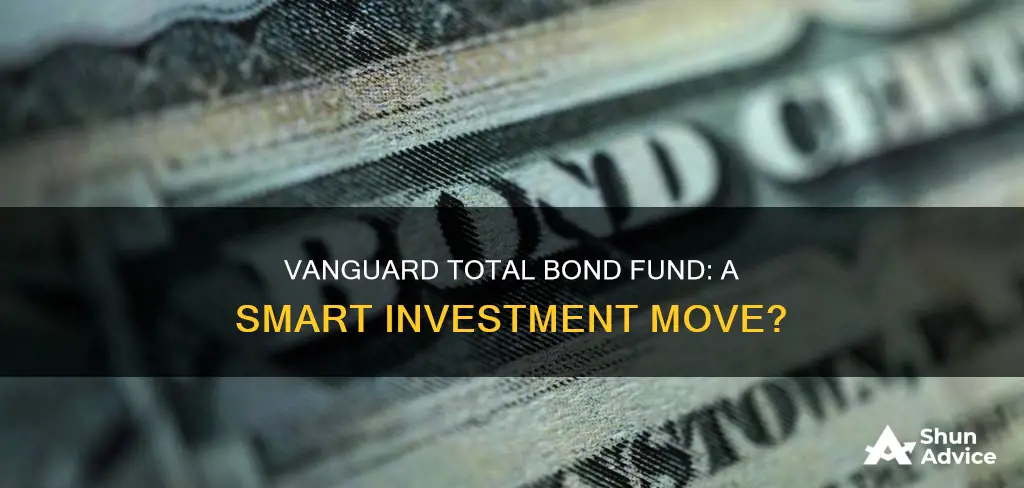
Vanguard is a well-known investment management company with a comprehensive suite of index funds, ETFs, and actively managed funds. One of their most popular offerings is the Vanguard Total Bond Market Index Fund, which seeks to replicate a broad bond index by investing in a diverse range of securities across maturities and sectors. This fund provides investors with exposure to the bond market, offering a liquid option in a traditionally illiquid sector. Vanguard's low-cost funds are excellent choices for long-term investors, and their brand is often associated with uncomplicated and reliable index funds.
| Characteristics | Values |
|---|---|
| Fund Name | Vanguard Total Bond Market Index Fund |
| Fund Type | Mutual fund or exchange-traded fund |
| Investment Objective | To track the performance of the Bloomberg U.S. Aggregate Float Adjusted Index |
| Investment Selection | Sampling process; at least 80% of assets invested in bonds held in the index |
| Holdings Diversity | Excellent |
| Bid/Ask Ratio | Typical |
| Holdings | U.S. Treasury Notes, U.S. Government Bonds, Corporate Bonds, Mortgage-Backed Securities, Asset-Backed Securities |
| Credit Rating | Investment-grade |
| Maturity | More than 1 year |
| Yield to Maturity | 4.6% |
| Average Duration | 6 years |
| Minimum Investment | $3,000 |
| Expense Ratio | 0.05% |
What You'll Learn

Vanguard Total Bond Market Index Fund's performance
Vanguard Total Bond Market Index Funds Performance
The Vanguard Total Bond Market Index Fund Admiral Shares (VBTLX) is one of the best total bond market index funds available today. With a history dating back to 1986, it is considered the oldest fund in its category and one of the oldest index funds in the US.
VBTLX offers a highly diversified portfolio, spanning over 11,100 government treasuries, mortgage-backed securities (MBS), and investment-grade corporate bonds. The fund has an average yield to maturity of 4.6% and a duration of six years, which measures total return potential and interest rate sensitivity, respectively. The minimum investment requirement for this fund is $3,000.
Vanguard's approach to bond investing has democratized the market, making it more accessible to retail investors. The fund leverages a transparent index, aggregating numerous bonds into a single, diversified, and low-cost portfolio with lower minimum investments. This has allowed retail investors to obtain broad access to a diversified portfolio of investment-grade bonds at a lower cost.
In terms of performance, VBTLX has consistently delivered strong returns. As of October 2024, it is ranked by Forbes as one of the seven best total bond market index funds. The fund's performance is further enhanced by its low expense ratio of 0.05%, which is well below the industry average.
Vanguard's total bond market index funds provide investors with broad exposure to the US bond market, including US Treasury bonds, agency bonds, corporate bonds, and other fixed-income investments. This diversification helps to lower portfolio volatility and generate income.
Overall, Vanguard's total bond market index funds, particularly VBTLX, offer a well-diversified and low-cost option for investors seeking exposure to the US bond market. The fund's performance has been solid, and its low fees make it a competitive choice in the market.
Fidelity Index Funds: Smart, Secure, Long-Term Investment Options
You may want to see also

Vanguard Total Bond Market Index Fund's pros and cons
Vanguard Total Bond Market Index Funds: Pros and Cons
Vanguard is known for its low-cost funds, and its total bond market index funds are no exception. Here are some pros and cons to help you decide if investing in Vanguard's total bond market index funds is the right choice for you:
Pros:
- Low Costs: Vanguard has a reputation for being a low-cost asset manager, and its total bond market index funds are no exception. This means you can access a diversified portfolio of investment-grade bonds at a lower cost compared to other fund providers.
- Diversification: Vanguard's total bond market index funds offer broad exposure to a wide range of bonds, including government, corporate, and mortgage-backed securities, providing investors with a well-diversified portfolio.
- Simplicity: Vanguard's funds are known for their uncomplicated approaches and reliable performance, making them a good choice for investors who want a simple and straightforward investment strategy.
- Liquidity: Investing in Vanguard's total bond market index funds provides exposure to the bond market with the added benefit of liquidity, which is not typically associated with traditional bond investments.
Cons:
- Interest Rate Risk: As with any bond fund, there is a risk that increases in interest rates will cause a decrease in the price of the bonds in the portfolio, leading to a lower net asset value for the fund.
- Minimum Investment: Some of Vanguard's funds, such as the Vanguard Total Bond Market Index Fund Admiral Shares (VBTLX), require a minimum initial investment of $3,000, which may be out of reach for smaller investors.
- Limited Active Management: While Vanguard's funds are known for their passive investment strategy, some investors may prefer a more actively managed fund that can adapt quickly to changing market conditions.
Overall, Vanguard's total bond market index funds offer a low-cost, diversified, and liquid option for investors seeking exposure to the bond market. However, it's important to consider the potential risks, such as interest rate sensitivity, and the minimum investment requirements before deciding if this investment aligns with your financial goals and risk tolerance.
Mutual Funds and Investment Trusts: What's the Difference?
You may want to see also

Vanguard Total Bond Market Index Fund's history
The Vanguard Total Bond Market Index Fund was launched in 1986 with the ticker VBMFX. Before its advent, individual bond investing was largely inaccessible to the average retail investor due to the complexities involved. Bonds were traded over-the-counter (OTC), and pricing information was not readily available or transparent. Investors had to rely on bond dealers for price quotes, which could vary significantly. In addition, the minimum investment amounts were typically high and out of reach for smaller investors.
The launch of VBMFX introduced a mutual fund structure that leveraged a transparent index. This approach aggregated numerous bonds into a single, diversified portfolio that was accessible at a lower cost and with lower minimum investments. This democratised access to bond markets, allowing retail investors to obtain broad access to a diversified portfolio of investment-grade bonds at a low cost.
Today, Vanguard continues to lead with a wide array of 114 bond mutual funds and exchange-traded funds (ETFs) that cater to various investor needs. Vanguard's bond fund lineup covers a wide range of bond types, including government bonds, corporate bonds, municipal bonds, and international bonds.
The Vanguard Total Bond Market Index Fund Admiral Shares (VBTLX) is one of the oldest index funds in the US, with its oldest share class first opening in 1986. VBTLX tracks the Bloomberg U.S. Aggregate Float Adjusted Index, a widely followed proxy for the entire U.S. bond market. The fund offers Vanguard Admiral Shares that require a $3,000 minimum initial investment. VBTLX owns well over 10,000 bonds and has an average effective duration of about six years. The portfolio has an allocation of roughly 45% to Treasury and agency bonds, about 20% to U.S. government mortgage-backed bonds, and about 15% to debt from industrial issuers.
The Vanguard Total Bond Market ETF (BND) seeks to track the performance of the Bloomberg U.S. Aggregate Float Adjusted Index, which measures the performance of a wide spectrum of public, investment-grade, taxable, fixed-income securities in the United States. This includes government, corporate, and international dollar-denominated bonds, as well as mortgage-backed and asset-backed securities, all with maturities of more than one year. At least 80% of its assets will be invested in bonds held in the index.
Unlocking Your Money: Withdrawing from Mainstay Investment Fund
You may want to see also

How does Vanguard Total Bond Market Index Fund compare to other bond funds?
The Vanguard Total Bond Market Index Fund is one of the oldest index funds in the US, with its oldest share class (VBMFX) first opening in 1986. The fund offers broad access to a diversified portfolio of investment-grade bonds at a low cost. The fund's performance objective is to track the Bloomberg U.S. Aggregate Float Adjusted Index, a widely followed proxy for the entire U.S. bond market. The fund has a high credit quality and moderate interest rate sensitivity, with a duration of around six years. This means that for each 1% rise or fall in interest rates, the fund's value can be expected to move by approximately 6% in the opposite direction.
Compared to other bond funds, the Vanguard Total Bond Market Index Fund stands out for its low expense ratios, which are well below the Morningstar category average. The fund's expansive portfolio includes over 10,000 bonds, with a yield to maturity of around 4.6% and an average duration of six years. The portfolio's allocation includes roughly 45% Treasury and agency bonds, about 20% U.S. government mortgage-backed bonds, and about 15% debt from industrial issuers.
The fund's performance and characteristics can be compared to other bond funds, such as the Northern Bond Index (NOBOX) and the TIAA-CREF Bond Index Advisor (TBIAX). The Northern Bond Index fund, founded in February 2007, has a similar average duration of roughly seven years and a diversified portfolio of around 3,300 bonds. The TIAA-CREF Bond Index Advisor, on the other hand, has a shorter average duration of about six years and holds more than 8,500 bonds.
Overall, the Vanguard Total Bond Market Index Fund offers a well-diversified portfolio of high-quality bonds with a relatively low expense ratio, making it a competitive option for investors seeking broad exposure to the US bond market.
Mutual Funds: Active Management Advantage Over Index Funds
You may want to see also

What are the alternatives to Vanguard Total Bond Market Index Fund?
There are several alternatives to the Vanguard Total Bond Market Index Fund. Here are some options:
Exchange-Traded Funds (ETFs)
ETFs are a popular alternative to mutual funds as they offer more flexibility and can be traded on an exchange like a stock. Here are some ETF alternatives to the Vanguard Total Bond Market Index Fund:
- IShares Agency Bond ETF
- IShares Core U.S. Aggregate Bond ETF
- IShares Intermediate Government/Credit Bond ETF
- IShares Government/Credit Bond ETF
- Vanguard Intermediate-Term Bond ETF
- Vanguard Long-Term Bond ETF
- Vanguard Short-Term Bond ETF
- PIMCO Enhanced Short Maturity Active Exchange-Traded Fund
- Invesco CEF Income Composite ETF
- Columbia Short Duration Bond ETF
- VanEck CEF Muni Income ETF
- Schwab U.S. Aggregate Bond ETF
- PIMCO Active Bond Exchange-Traded Fund
- FlexShares Ultra-Short Income Fund
- IShares Core 10+ Year USD Bond ETF
- IShares Core 1-5 Year USD Bond ETF
- Vanguard Total International Bond ETF
- SPDR SSgA Ultra Short Term Bond ETF
- WisdomTree Interest Rate Hedged U.S. Aggregate Bond Fund
- IShares Yield Optimized Bond ETF
- IShares Core Total USD Bond Market ETF
- First Trust Enhanced Short Maturity ETF
- Fidelity Total Bond ETF
- Vident U.S. Bond Strategy ETF
- SPDR DoubleLine Total Return Tactical ETF
- VictoryShares Core Plus Intermediate Bond ETF
- IShares Short Duration Bond Active ETF
- IShares Core International Aggregate Bond ETF
- Invesco Total Return Bond ETF
- PIMCO Enhanced Low Duration Active ETF
- SPDR DoubleLine Short Duration Total Return Tactical ETF
- RiverFront Dynamic Core Income ETF
- Nuveen Enhanced Yield U.S. Aggregate Bond ETF
- Invesco Variable Rate Investment Grade ETF
- IShares Core 5-10 Year USD Bond ETF
- FlexShares Core Select Bond Fund Core Select Bond Fund
- IShares U.S. Fixed Income Balanced Risk Systematic ETF
- First Trust TCW Opportunistic Fixed Income ETF
- VanEck Green Bond ETF
- Nuveen ESG 1-5 Year U.S. Aggregate Bond ETF
- WisdomTree Yield Enhanced U.S. Short-Term Aggregate Bond Fund
- Hartford Total Return Bond ETF
- Nuveen ESG U.S. Aggregate Bond ETF
- Columbia Diversified Fixed Income Allocation ETF
- SPDR Portfolio Aggregate Bond ETF
- VictoryShares Short-Term Bond ETF
- VictoryShares Core Intermediate Bond ETF
- PGIM Ultra Short Bond ETF
- Hartford Schroders Tax-Aware Bond ETF
- First Trust TCW Unconstrained Plus Bond ETF
- ClearShares Ultra-Short Maturity ETF
- Vanguard Total World Bond ETF
- Anfield Universal Fixed Income ETF
- Western Asset Total Return ETF
- JPMorgan Ultra-Short Municipal Income ETF
- IShares ESG Aware US Aggregate Bond ETF
- JPMorgan Municipal ETF
- IShares Trust iShares USD Green Bond ETF
- First Trust Low Duration Strategic Focus ETF
- JPMorgan Core Plus Bond ETF
- Western Asset Short Duration Income ETF
- JPMorgan BetaBuilders 1-5 Year U.S. Aggregate Bond ETF
- SPDR SSGA Fixed Income Sector Rotation ETF
- Virtus Seix Senior Loan ETF
- Franklin U.S. Core Bond ETF
- Overlay Shares Core Bond ETF
- PIMCO Enhanced Short Maturity Active ESG Exchange-Traded Fund
- SP Funds Dow Jones Global Sukuk ETF
- And many more...
Mutual Funds
Mutual funds are another alternative to consider. Here are some similar mutual funds to the Vanguard Total Bond Market Index Fund:
- TIAA-CREF Bond Index Advisor (TBIAX)
- Northern Bond Index (NOBOX)
- Fidelity Sustainability Bond Index Fund (FNDSX)
- Fidelity U.S. Bond Index Fund (FXNAX)
- Fidelity Flex US Bond Index Fund (FIBUX)
These mutual funds offer exposure to the bond market and can provide a good alternative for investors who prefer the structure and features of mutual funds over ETFs.
Mutual Fund SIPs: Invest Now or Later?
You may want to see also
Frequently asked questions
A total bond fund is a mutual fund or exchange-traded fund that seeks to replicate a broad bond index. It offers investors exposure to the bond market and is a very liquid option compared to traditional bond investments.
The fund invests about 30% in corporate bonds and 70% in U.S. government bonds of all maturities (short-, intermediate-, and long-term issues).
Vanguard funds tend to be low-cost and pursue simple, reliable strategies. They are excellent choices for long-term investors looking to build a well-diversified portfolio.
The minimum investment required is $3,000.
As of June 2022, the fund had a 10-year annualized return of 1.34%.







